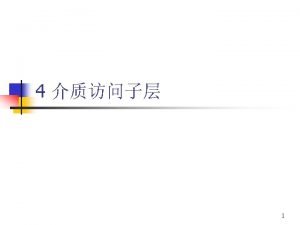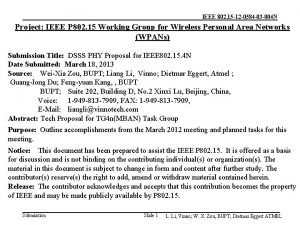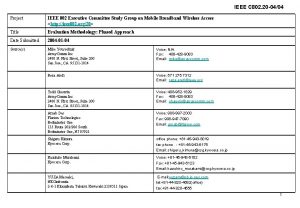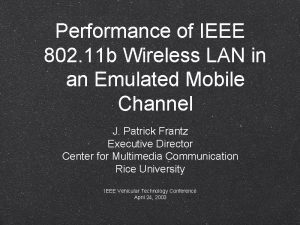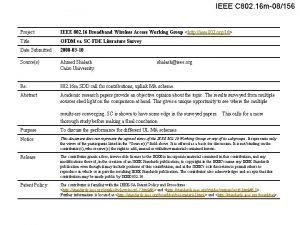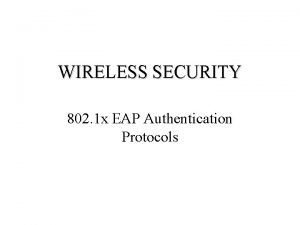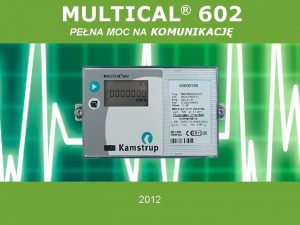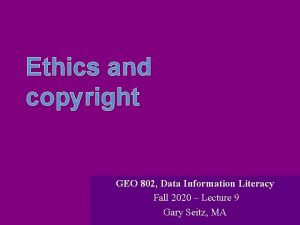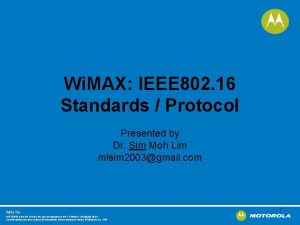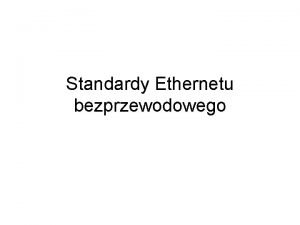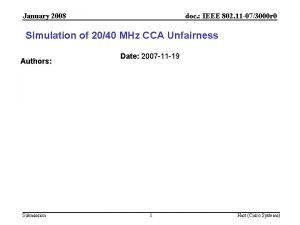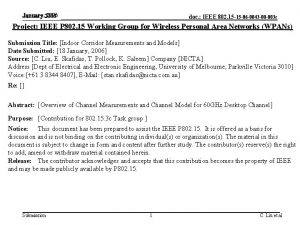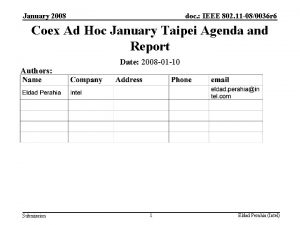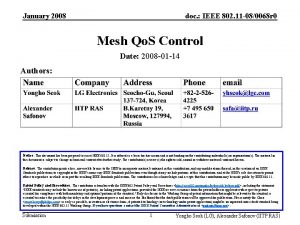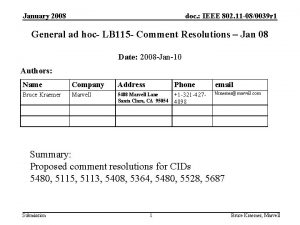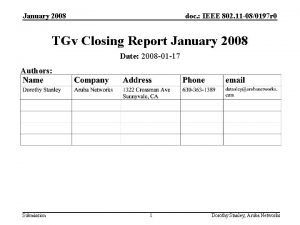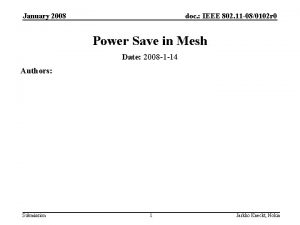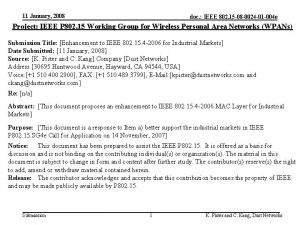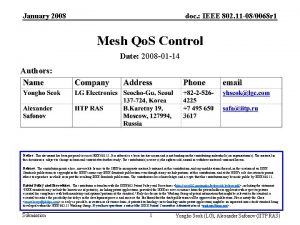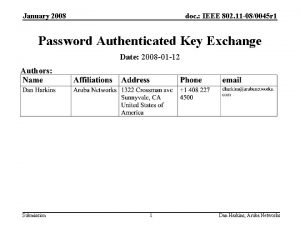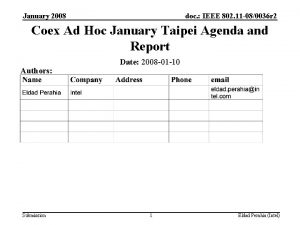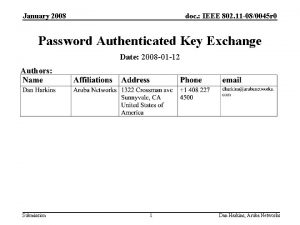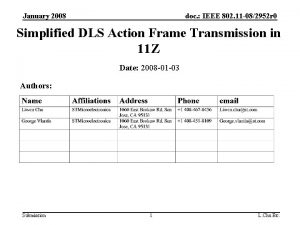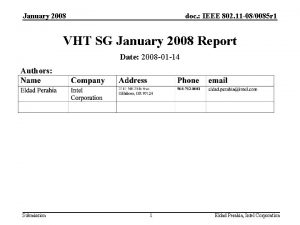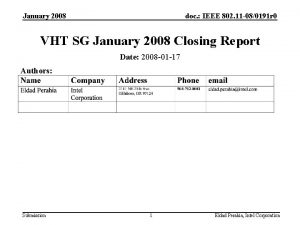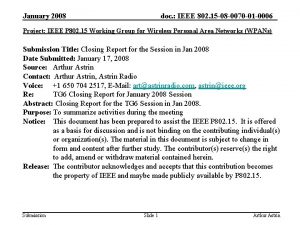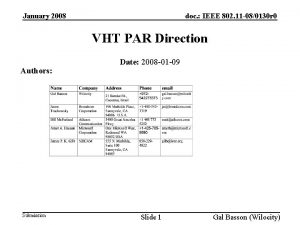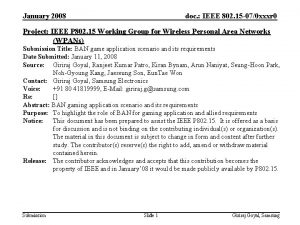January 2008 doc IEEE 802 11 073000 r

























- Slides: 25

January 2008 doc. : IEEE 802. 11 -07/3000 r 1 Simulation of 20/40 MHz CCA Unfairness Authors: Submission Date: 2007 -11 -19 1 Hart (Cisco Systems)

January 2008 doc. : IEEE 802. 11 -07/3000 r 1 Comment CID 5362 Com ment er Hart, Brian LB 115 Submission Draft 3 Clause Numbe r(C) Page( C) Line( C) Type of Com ment Part of No Vote Comment Proposed Change 11. 9. 8. 3 205 59 T N We have failed to produce a 20/40 coexistence scheme that is both fair to legacy devices yet enables 40 MHz operation where such operation does not substantially degrade fairness. With the current spec, many cases of asymmetric channel access (i. e. asymmetric hidden nodes) can be pointed to. This is because presently there is no virtual carrier sense on the secondary, weak physical carrier sense on the secondary, weak requirements on starting a 20/40 BSS at 5 GHz, and no in-service scanning requirements on the 20/40 BSS at 5 GHz. If a legacy user finds their legacy Wi. Fi experience is severely degraded by 11 n devices and there is no way to help the user except by saying "manually change your channel away from the secondary of a busy 5 GHz BSS as soon you manually detect that a busy BSS has chosen to camp next to your channel" then we haven't done a very good job. s Make degrading a legacy user's Wi. Fi experience the last choice: revisit more stringent CCA thresholds on the secondary, stronger rules for starting a 20/40 BSS, stronger rules for inservice scanning. Reward devices that are fairer: for instance allow relaxed scanning rules for devices that have sensitive secondary CCA thresholds. 2 Hart (Cisco Systems)

January 2008 doc. : IEEE 802. 11 -07/3000 r 1 We have defined CCA for 20/40 MHz operation, but not performed a detailed analysis of its effects • How should we analyze this? − Analyze a very simple “home” scenario − Two BSSs: one in a 20 mx 30 m lot, another BSS in a nearby 20 mx 30 m lot − Assume one BSS is 40 MHz; one BSS is 20 MHz in the secondary Submission 3 Hart (Cisco Systems)

January 2008 doc. : IEEE 802. 11 -07/3000 r 1 D 3. 0 CCA rules on the secondary 20. 3. 21. 5. 2 Clear channel assessment (CCA) sensitivity in 40 MHz …The receiver of a 20/40 MHz STA with the operating channel width set to 40 MHz shall provide CCA on both the primary and secondary channels. … When the primary channel is idle, the receiver shall hold the 20 MHz secondary channel CCA signal busy for any signal at or above – 62 d. Bm in the 20 MHz secondary channel. The receiver shall hold both the 20 MHz primary channel CCA and the 20 MHz secondary channel CCA busy for any signal present in both the primary and secondary channel that is at or above – 62 d. Bm in the primary channel and at or above – 62 d. Bm in the secondary channel. Submission 4 Hart (Cisco Systems)

January 2008 doc. : IEEE 802. 11 -07/3000 r 1 Two lots, two BSSs, six links, 12 RSSIs • Randomly place devices throughout each lot • Calculate RSSIs with random shadowing • Analyze who is unfair to whom Submission 5 Hart (Cisco Systems)

January 2008 doc. : IEEE 802. 11 -07/3000 r 1 Calculate RSSIs via the standard pathloss model • RSSI = P + Gtx + Grx + PL@1 m - 10*PLE*log 10(d) + N(0, 7) • P = Power. In. Secondary = 40 MHz ? 12 : 15 d. Bm • Gtx = Is. AP ? 2 : 0 • Grx = Is. AP ? 2 : 0 • PL@1 m = -46. 9 at 5 GHz • PLE = 3. 5 • D = distance in m • N(0, 7) = 7 d. B of log-normal shadowing • Reciprocity is enforced Submission 6 Hart (Cisco Systems)

January 2008 doc. : IEEE 802. 11 -07/3000 r 1 Analyze each scenario for unfairness • Assume a NF and a minimum BSS SINR • Scenario is admissible if min RSSI on AB, BA, CD, DC > SINR+NF • AB BSS can be unfair to CD BSS via 4 links (AC, AD, BC, BD) • If AB BSS is unfair to CD BSS via AC, then add 25%. − Ditto AD, BC, BD • CD BSS can be unfair to AB BSS via 4 links (CA, DA, CD, DB) • If CD BSS is unfair to AB BSS via CA, then subtract 25%. − Ditto DA, CB, DB • Summary: − Unfairness of 100% means AB BSS is unfair to CD BSS on all 4 links − Unfairness of -100% means CD BSS is unfair to AB BSS on all 4 links − Unfairness of 0% means no unfairness Submission 7 Hart (Cisco Systems)

January 2008 doc. : IEEE 802. 11 -07/3000 r 1 Definition of Unfairness • Sustained, harmful unfairness • Node A is unfair to node C if: − A does not defer when C transmits − The SINR at node B when nodes A and C are transmitting is greater than the SINR threshold − C does defer when A transmits OR the SINR at node D when nodes C and A are transmitting is less than the SINR threshold • That is, A can happily transmit to B without penalty and without regard to C, but either C cannot transmit or C’s transmissions are collided with by A Submission 8 Hart (Cisco Systems)

January 2008 doc. : IEEE 802. 11 -07/3000 r 1 Simple Example of 100% Unfairness • AB is -50 d. Bm • CD is -80 d. Bm • AC, AD, BC, BD are -80 d. Bm • AB never defer to CD • AB experiences a SINR of 30 d. B, so AB never backoff • Any A or B transmission destroys any C or D transmission (0 d. B SINR) Submission 9 Hart (Cisco Systems)

January 2008 doc. : IEEE 802. 11 -07/3000 r 1 Simulation Notes • This is a PHY-level simulation, showing how the PHY can present poor information to the MAC • The impact on throughput and delay depends on traffic patterns − Needs a MAC simulation to resolve − Yet, if there is dense traffic on the 40 MHz BSS, and 100% unfair locations, then throughput on the secondary will be essentially zero. • 2000 simulation runs at each data point, so the effects of topology/location and shadowing are well averaged out − What is left is the CCA rule and any TX power imbalance Submission 10 Hart (Cisco Systems)

January 2008 doc. : IEEE 802. 11 -07/3000 r 1 Up to 24% unfairness • Up to 24% unfair locations in adjacent lots • Unfair locations are common for up to 15 -20 d. B SINR • Same 20/40 power due to FCC limits or battery limits • Power in secondary of 40 MHz device is less than 20 MHz devices hence mild unfairness at large range Submission 11 Hart (Cisco Systems)

January 2008 doc. : IEEE 802. 11 -07/3000 r 1 Did we cherry pick this example? • Try a second example: − Assume BSSs are entirely inside houses, and houses occupy half the lot Submission 12 Hart (Cisco Systems)

January 2008 doc. : IEEE 802. 11 -07/3000 r 1 In fact, the within-home-BSS problem is even worse • Up to 37% unfair locations in adjacent lots • Unfair locations are common for all SINRs • Same 20/40 power assumed • Power in secondary of 40 MHz device is less than 20 MHz devices hence mild unfairness at large range Submission 13 Hart (Cisco Systems)

January 2008 doc. : IEEE 802. 11 -07/3000 r 1 Within same-room BSSs is worse still, with up to 72% unfairness • E. g. media server, AP and display in a 4 x 5 m room • Up to 72% unfair locations • Unfair locations are common for all SINRs • Unfair locations are common out to first (20 m) and second (40 m) adjacent lots • Typical failure mechanism: AB and CD could transmit to each other happily (-40 d. Bm), yet CD sees AB at -75 d. Bm & defers; and so AB can monopolize the channel Submission 14 Hart (Cisco Systems)

January 2008 doc. : IEEE 802. 11 -07/3000 r 1 Enterprise BSSs need channel planning + the DFS channels to avoid unfairness • E. g. One 40 MHz AP in a conference room; how quickly can that secondary channel be reused? • Assume channel planning, 400 m 2 per AP; AP at mid. BSA • For 1 floor, channel planning can mostly stop unfairness • For 3 -floors, channel planning needs the DFS channels to reasonably limit unfairness Submission 15 Hart (Cisco Systems)

January 2008 doc. : IEEE 802. 11 -07/3000 r 1 Previous analysis is not inconsistent with these results • 06/608 r 1 indicates that no CCA on secondary is a bad idea • 06/608 r 1 achieves acceptable sharing when CCA-ED on the secondary is added • The CCA-ED threshold is not listed, but it seems to be low enough that CCA is being asserted • Therefore 06/608 r 1 does not seem to be simulating the scenario in this submission. • 06/608 r 1 does not appear to have anything to say when a 20 MHz BSS on the secondary does not trigger CCA in the 20/40 MHz BSS • If anything 06/608 r 1 reiterates the point of this submission: bad things happen when CCA on the secondary is non-existent (or ineffective) Submission 16 Hart (Cisco Systems)

January 2008 doc. : IEEE 802. 11 -07/3000 r 1 Three Alternatives 1. Major / Significant Impact on Legacy Operation in Ext Ch • No CCA on extension channel • Dramatic negative impact on throughput of both HT and Legacy devices 2. Slight Impact on Legacy Operation in Ext Ch • Mandatory independent CCA on both Control and extension channel (ED CCA for ext ch) • Mandatory to avoid 40 MHz transmissions when ext ch CCA is busy • Relatively Fair Sharing of Medium ED = Energy Detect, CCA = Clear Channel Assessment Submission 17 3. Minimal Impact on Legacy Operation in Ext Ch • Mandatory independent CCA on both Control and extension channel (ED CCA for ext ch) • Mandatory to avoid 40 MHz transmissions when ext ch CCA is busy • Independent back-off counters for both Control and Ext Channels • Including back off counter for ext ch provides some improvements in favor of legacy networks over alt. 2 Hart (Cisco Systems)

January 2008 doc. : IEEE 802. 11 -07/3000 r 1 Lessons • Implementers should strongly consider not placing their 40 MHz secondary on top of another’s 20 MHz BSS • Implementers should implement a better CCA on the secondary channel − Should be accompanied by some modest incentive for implementers − But what? 5 GHz basically has no relax-able requirements − Therefore just add new language in the standard Submission 18 Hart (Cisco Systems)

January 2008 doc. : IEEE 802. 11 -07/3000 r 1 Questions? ? Submission 19 Hart (Cisco Systems)

January 2008 doc. : IEEE 802. 11 -07/3000 r 1 Strawpoll Do you agree that the existing weak secondary CCA requirements are a problem that we should try to improve without affecting legacy compliance? Y N A Submission 20 Hart (Cisco Systems)

January 2008 doc. : IEEE 802. 11 -07/3000 r 1 Candidate Comment Resolutions In 20. 3. 21. 5. 2, insert: The receiver [shall | should | may] additionally implement an enhanced CCA on the 20 MHz secondary channel. The enhanced CCA satisfies one or both of the following: - When the primary channel is idle, the start of a valid 20 MHz HT signal in the secondary channel at a receive level equal to or greater than the minimum modulation and coding rate sensitivity of – 82 d. Bm causes the PHY to set PHY-CCA. indicate(BUSY, {secondary}) with a probability > 90% within 4 μs. - When the primary channel is idle, the receiver shall hold the 20 MHz secondary channel CCA signal busy for any signal at or above – 72 d. Bm in the 20 MHz secondary channel. Submission 21 Hart (Cisco Systems)

January 2008 doc. : IEEE 802. 11 -07/3000 r 1 Strawpoll Do you prefer “shall”, “should”, “may” in the previous text, or no text at all? Vote for 1 or more Shall Should May No Text Change Abstain Submission 22 Hart (Cisco Systems)

January 2008 doc. : IEEE 802. 11 -07/3000 r 1 Backup Slides Submission 23 Hart (Cisco Systems)

January 2008 doc. : IEEE 802. 11 -07/3000 r 1 What About Excess Inter-Property Pathloss? • Same as slide 13, but adding 10 d. B inter-property loss • Minimal changes in unfairness • Unfairness appears at closer distances Submission 24 Hart (Cisco Systems)

January 2008 doc. : IEEE 802. 11 -07/3000 r 1 Preliminary Measured Results • A 20/40 MHz BSS in a shield box (top right), and a 20 MHz BSS on the secondary in another shield box (bottom right), connected via a variable attenuator • APs do sensitive preamble CCA both P+S (beyond the standard) + insensitive CCA-ED • 20/40 client CCA follows the std • Inter-BSS atten increases L-to-R • When CCA-ED in use (L), it’s all good. Once the CCA-ED doesn’t get triggered (mid), thruput degrades nearly 50%. Submission 25 Hart (Cisco Systems)














